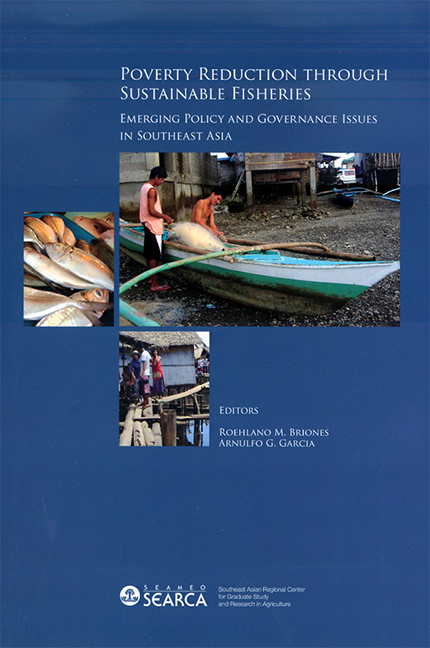 Poverty Reduction through Sustainable Fisheries
Poverty Reduction through Sustainable Fisheries Book contents
- Frontmatter
- Contents
- Figures
- Tables
- Foreword
- Acknowledgments
- 1 Introduction and Synthesis
- 2 Fish and the Poor
- 3 Fish and the Poor: The Case of Cambodia
- 4 Changing Demand and Supply Structure of Fish in Asia: Past Trends and Future Projections
- 5 Regional Economic Integration of the Fisheries Sector in ASEAN Countries
- 6 Technology Policies for Capture Fisheries and Aquaculture in Southeast Asia
- 7 The Status, Current Trends and Future Directions for Production and Technology of Fisheries in Southeast Asia
- 8 The Seafood Supply Chain and Poverty Reduction
- 9 Strategy for the Empowerment of Aquaculture Fish Farmers in Indonesia
- 10 Status of Coastal and Marine Resources: Implications for Fisheries Management and Poverty in Southeast Asia
- 11 Property Rights and Institutional Arrangements in Southeast Asian Fisheries
- 12 Regional Cooperation in Aquatic Resource Management for Southeast Asia
6 - Technology Policies for Capture Fisheries and Aquaculture in Southeast Asia
Published online by Cambridge University Press: 21 October 2015
- Frontmatter
- Contents
- Figures
- Tables
- Foreword
- Acknowledgments
- 1 Introduction and Synthesis
- 2 Fish and the Poor
- 3 Fish and the Poor: The Case of Cambodia
- 4 Changing Demand and Supply Structure of Fish in Asia: Past Trends and Future Projections
- 5 Regional Economic Integration of the Fisheries Sector in ASEAN Countries
- 6 Technology Policies for Capture Fisheries and Aquaculture in Southeast Asia
- 7 The Status, Current Trends and Future Directions for Production and Technology of Fisheries in Southeast Asia
- 8 The Seafood Supply Chain and Poverty Reduction
- 9 Strategy for the Empowerment of Aquaculture Fish Farmers in Indonesia
- 10 Status of Coastal and Marine Resources: Implications for Fisheries Management and Poverty in Southeast Asia
- 11 Property Rights and Institutional Arrangements in Southeast Asian Fisheries
- 12 Regional Cooperation in Aquatic Resource Management for Southeast Asia
Summary
ABSTRACT
Fisheries and aquaculture production are significant to Southeast Asian economies, mostly for food security and livelihood source. Its output in the sector steadily increased in the last forty years. However, a thorough examination of existing technologies for the fisheries sector is still needed before policies can be formulated. This paper discusses technology profiles for aquaculture and capture fisheries in the Southeast Asian region, and also provides national action plans for Indonesia, Malaysia, Philippines, Thailand, and Vietnam.
OVERVIEW
The capture fisheries and aquaculture sectors are of fundamental importance to Southeast Asia in terms of food security, revenue generation, and employment. Both catching and farming aquatic resources form a vital part of the rural people's livelihoods in several countries. Culturally, aquatic resources mean more than just a source of income or food supply. Traditional fishery products such as fish sauce and fish-based condiments are significant ingredients of people's daily diet and are not easily substituted. All sizes and types of fish are utilised with very little wastage. Only recently has it become apparent that fish play an essential role in both the food security and nutritional security of many rural and coastal populations.
Fisheries and aquaculture production contribute significantly to national economies across the Southeast Asian region. This region is a major producer of fish, both from aquaculture and capture. In the last four decades, output growth has been very strong (APFIC 2004). Still, strategies for the sector must take careful consideration of the characteristics of the technology both in aquaculture and fisheries. This paper provides a profile of aquaculture and capture technologies in Southeast Asia, as well as a discussion of policy issues and action plans. It draws heavily from a study conducted by the WorldFish Center and partner national research organisations throughout the region (WorldFish Center 2005).
PROFILE OF TECHNOLOGIES
Aquaculture
Aquaculture, originally dedicated to ornamental fish and for subsistence (e.g., naturally stocked water catchments), has been developed for several centuries in Southeast Asia.
- Type
- Chapter
- Information
- Poverty Reduction through Sustainable FisheriesEmerging Policy and Governance Issues in Southeast Asia, pp. 107 - 126Publisher: ISEAS–Yusof Ishak InstitutePrint publication year: 2008


